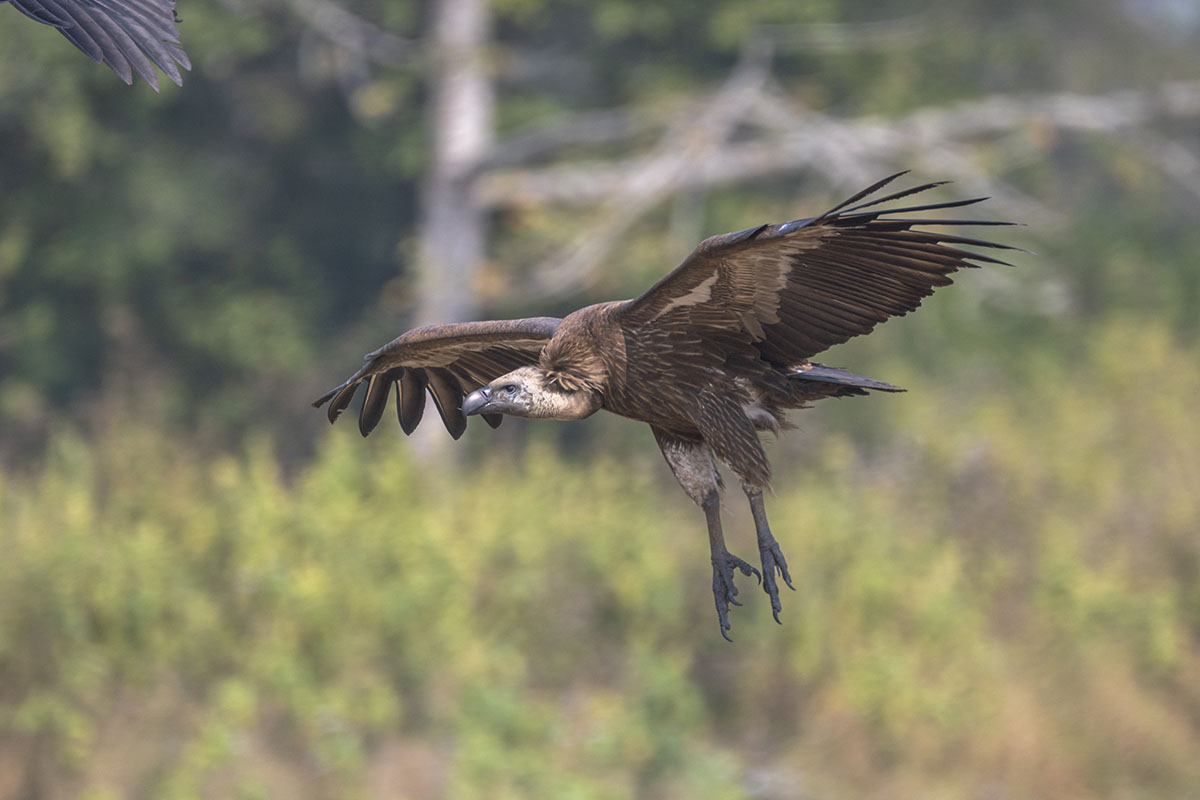With just a couple of days of preparation, I left Kathmandu for a month-long stay in Kawasoti with fellow participants Jonas Böttern from Sweden and Nilanjana Nandy from India for the residency.
I don’t recall myself staying outside the valley in a single place for a month. This was a new experience for a guy who used to have a pretty active nomadic outdoor itinerary. But I was super excited to experience and learn about a new place, its Tharu heritage, and the vulture conservation this place is known for.
Settled in our designated home for the month, the Heaven Green Jungle Resort, we finally got to meet DB Chaudhary and the team from Jatayu. The conversation centered around Jatayu and Bird Conservation Network’s work, as well as our area of research for the month.
The Jayatu Vulture Restaurant, located on the outskirts of Laukani, Kawasoti, is the brainchild of DB Chaudhary and is the first community-managed vulture feeding station. This place has been a haven for vultures since 2007, as it provides Diclofenac-free dead cattle given by cattle farmers around the community as food to vultures. The creation of this system and space has resulted in an increase in population and even different species of vultures in the area. The nesting has also increased significantly.
The next day, we went on a visit to the Jatayu Vulture Restaurant and also the Namuna Community Forest. Entering Jatayu, we could instantly see the vultures, either perched on the big simal trees or sitting on the nests. I can’t imagine the amount of effort the team has put into making this place a safe sanctuary for vultures. This is commendable work that needs to be shared more.
Jatayu has a bird hide to observe the vultures up close, so we got ourselves a seat to observe them while feeding. As the animal carcass was placed in the center of the open ground, vultures began flying in. The sheer number of vultures that came to the feeding was impressive. I got to witness five species of vultures in one place. After the feeding, we slowly headed to the Namuna Community Forest, which was another beautiful spot to visit.
Community forests in Nepal have been a model for conservation, and this was one of those success stories as well. The community forests that I have visited in the Tarai region have been a source of inspiration and a place where I have had a lot of my flora and fauna sightings. The other aspect of Namuna Community Forest that I was happy to see was its grasslands.
There are always talks about tree plantations when it comes to saving biodiversity, but grasslands are equally important, if not more. We have lost a lot of grassland in the Tarai region, as well as places at higher elevations, and we are losing more still, so the conservation of these places is critical. This community forest was one exception where I was able to see that the grassland was taken seriously.
Walking through the grasslands of the Namuna Community Forest, we headed to the banks of the Narayani River and got to see some of the migratory birds that had arrived in Nepal. There were Bar-headed Goose, Gadwall, Mallards, Ruddy shelduck, Common teal, along with many other birds, like the Pied kingfisher and the Common sandpiper.
We were also able to learn about the Tharu heritage, the indigenous methods of conserving forests, ways of maintaining grasslands, the displacement of the indigenous Tharu community when the Chitwan National Park was established, the haphazard way of distributing land to the people from outside the region that have now created problems in the biodiversity of the place and a lot of stories about the area through Birendra Mahato, the director of the Tharu Cultural Museum and Research Center in Sauraha.
This was one of those invaluable moments to know about Chitwan, and especially the indigenous Tharu community who have lived here since time has known.
On the remaining days of the month, we attended multiple feedings and learned more about the birds at the Jatayu Vulture Restaurant. The resident program is still ongoing, and I am excited to see what the rest of my time here has in store for us.
Below are some of the species of flora and fauna that I was able to spot in February.
Birds:
Baya Weaver, Grey-breasted Prinia, River Lapwing, Common Kingfisher, White-rumped Vultures, Himalayan Griffon vulture, Cinereous vulture, Red-headed vulture, Slender-billed vulture, Ruddy Shelduck, Eastern Imperial Eagle, Osprey, Red-wattled Lapwing, Little Cormorant, Black Kite, Common Teal, White Wagtail, Pied Kingfisher, Red-whiskered Bulbul, Jungle Myna, Common Myna, Fulvous-breasted Woodpecker, Pied Bushchat, Plum-headed Parakeet, Greater Coucal, Indian Pond Heron, Red-billed Blue Magpie, Common Tailorbird, Black-hooded Oriole, Rufous Treepie, Jungle Owlet, Lesser Adjutant, White-breasted Waterhen, Long-tailed Shrike, Black Drongo, Stork-billed Kingfisher, White-throated Kingfisher, Red-vented Bulbul, Red-naped Ibis, Indian Roller, Common Sandpiper, etc.
Mammals:
One-horned Rhino, Spotted Deer, Golden Jackel, Jungle Cat, Wild Boar.
Reptile:
Flora:
Simal Tree (Bombax ceiba), Bakena tree (Melia azedarach), Water hyacinth (Eichhornia crassipes), Water Cabbage (Pistia stratiotes), Sal (Shorea Robusta), Curry Leaf Plant (Bergera koenigii), etc.
Ajay Narsingh Rana is a wildlife, nature and adventure photographer and videographer. Ajay also writes about nature and conservation on his blog prakritinepal.com as well as for local print media.

